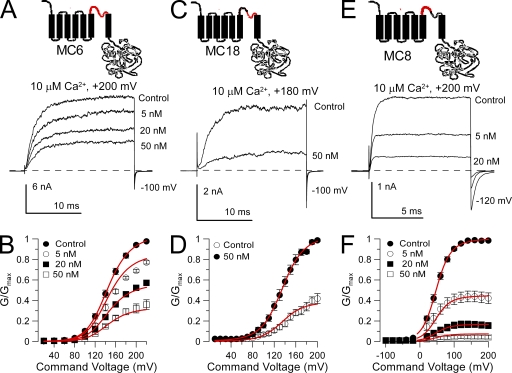Figure 4.
The P loop segment modestly influences paxilline sensitivity. (A) Exchanging the Slo1 P loop with the homologous Slo3 sequence (MC6) on paxilline sensitivity has little or weak effects on paxilline sensitivity. The MC6 construct is schematized on the top. Traces show the effect of various paxilline concentrations on MC6 currents evoked by a step to +200 mV with 10 µM Ca2+. (B) G-V curves are plotted for MC6 with and without paxilline (n = 4–5 patches). The red lines correspond to the best fit of a model in which paxilline blocks both open and closed channels identically (Kb = 23.2 ± 1.0 nM) with no voltage dependence. (C) Replacing the second half of the Slo1 P loop with the homologous Slo3 sequence (MC18) has little effect paxilline sensitivity. The MC18 construct is diagrammed at the top. Traces show MC18 currents activated with 10 µM Ca2+ at +180 mV with and without paxilline. (D) G-V curves are plotted for MC18 with and without paxilline (n = 4 patches), with the red lines showing a fit of Eq. 2 with Kb = 30.0 ± 1.4 and z = 0 e. (E) Replacing the first half of the Slo1 P loop with the homologous Slo3 sequence (MC8) increases paxilline sensitivity. The MC8 construct is diagrammed at the top. Traces show MC8 currents activated with 10 µM Ca2+ at +200 mV in the presence and absence of paxilline. (F) G-V curves are displayed for MC8 with and without paxilline (n = 5 patches). Red lines correspond to a fit of Eq. 1 with equivalent open- and closed-channel block (Kb = 4.04 ± 0.10 nM) with no voltage dependence.

